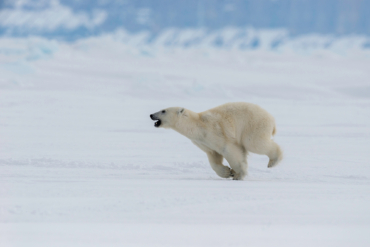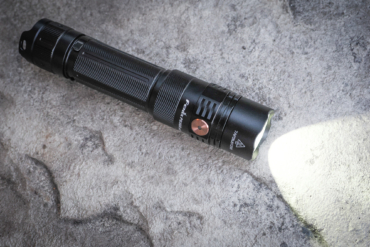I hear a noise and turn. In an instant, I notice a bear charging. Fumbling for my bear spray, I take aim and mash the firing button—too late! Thank goodness it was just a robot.

The Greater Yellowstone grizzly bear population grew from fewer than 200 hundred bears to more than 700 in four decades of Endangered Species Act protection.
Now, run-ins are on the rise in Idaho, Montana, and Wyoming as the bears’ range expands alongside urban sprawl. Convincing people to carry bear spray is the first challenge. Using it fast enough is a close second.
In Idaho, wildlife experts designed a robot that replicates a charging bear to help train people to properly use bear spray.
Watch the video below to see it in action.
Bear Spray Robot
“A common mistake is people just wait too long to deploy their bear spray,” said Chris Kula, a wildlife biologist for the Caribou-Targhee National Forest. I traveled to meet him and learn more about the simulation.
The charging bear simulator helps fix those mistakes. It’s an archery bear decoy launched down 40 feet of track. Its simulated charge helps teach people how to use bear spray. But it also reveals how quickly people unravel when a bear is in their bubble.

“They are surprised at how soon the bear is there. They are surprised how difficult it is for them to get the bear spray operating even though they know it’s going to happen,” says Tony Appelhans, Idaho Master Naturalist member and simulator builder. “When you turn around and see that funny little bear coming at you, it just stops you thinking.”
Bear Spray vs. Robot Bear: Real Life Test
As an outdoor journalist, I work in the woods often. I carry bear spray always. And it’s in my hand never. That’s the first mistake I make when the decoy bear charges me. I’m still fumbling with the holster and safety clip when the bear bumps into my feet.
Bear safety experts Appelhans and Kula bust a gut. Their laughter is so loud it echoes through the forest, alerting any real bears within earshot. We’re in the eastern Idaho woods, an hour outside of Yellowstone National Park. There are bears. The black and grizzly kind.

Second try, second mistake. I wait for the bear to get close so I’m sure I spray directly in its face. Don’t do that. We used fake spray, which is a harmless white mist. Real bear spray is potent and creates a red pepper cloud.
You want that cloud between you and the bear. If you wait for close proximity so you can spray the pepper directly on the bear, the bear is going to be directly on you.
Try three. Spray starts in hand, not holster. I turn, create a cloud with a 1–2-second burst. I don’t empty the can. This I get right. I know bears may back off and then start over. I’m saving spray for a second charge. Cans only hold up to seven seconds of spray. Don’t blow it all in the first shot.
After three tries, I start focusing on speed. This is the hardest correction. Real bears move three times faster than the decoy. The speed at which a real situation unfolds is unbelievable.
I thought I was pretty bear aware, but I thought wrong. This response test is a harsh reality check.
Even with a slower simulation advantage, human response time is still seriously lacking.
The simulator really opened my eyes. I hope to never have to deploy bear spray, but after running the simulation a couple times, I feel more prepared, and more confident too.
Outdoor journalist Kris Millgate is based in Idaho Falls, Idaho. See more of her work at www.tightlinemedia.com







